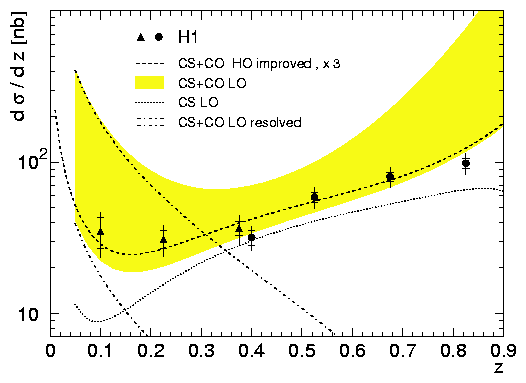
Inelastic Photoproduction of J/psi Mesons at HERA |
As we know from many experiments, protons consist of quarks and gluons. In fact, they consist mainly of 'light' quarks, and the production of 'heavy' quarks, that is a charm or bottom quarks, in electron proton collisions at HERA is a signature for reactions with gluons. Gluons are the carriers of the strong force and carry themselves the strong force charge, called colour. They don't react directly with electrons or photons, which are emitted from the electron. But if the gluons split into a quark anti-quark pair, one of the quarks can react with the photon.
The J/psi meson is a bound state of a 'charm' and an 'anti-charm' quark, one of the 'heavy' quarks. The theory of the strong force , Quantum Chromodynamics, tells us that all particles which can be observed are colourless (even more they are in a colour-singlet state). This applies also to the J/psi meson. So, if we have a coloured gluon, that splits into a charm anti-charm pair to form a J/psi, where does the colour go?
Several models are 'on the market' to describe J/psi production, here we concentrate on two of them:
The J/psi mesons are mostly produced at values of z above ~0.45. In this region the prediction of the Colour Singlet Model (dotted curve) shows the same form as the data, but lies about a factor 1.5 too low. This factor can be explained in the model. At lower values of the elasticity the CSM falls much below the data and cannot describe the form any more.
If you now add the 'colour-octet' contributions for the full NRQCD prediction, you get the yellow band: for a small amount of 'colour-octet' contributions the lower edge is obtained, for a large amount the upper edge. The lower edge agrees with the data quite well. This means there is room for contributions from 'colour-octet' states in the data and the HERA data could be reconciled with the proton anti-proton data.
You can learn even more from this plot: In the region of low z, a second class of processes contributes to J/psi production, where the photon does not contribute its complete energy to the reaction, but breaks up before. This type of process is called 'resolved photon' and the upper and lower edges are shown as the dashed-dotted lines.
